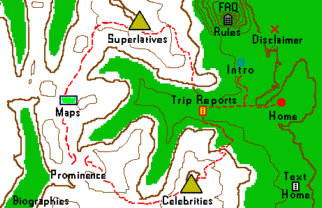
| Washington Peak Seasonality |

|
An electronic mail discussion about the optimal months for climbing the tougher Washington county highpoints is provided. The discussion arose in early 2009 when Adam Helman described his "APEX" highpointing goals for the next few summers to a group of Washington county highpointers.
Descriptions for Mount Baker, Glacier Peak, and Mount Rainier are forthcoming.
(Edward Earl)
Here is my take on the seasonality of Adam's most critical peaks:
Bonanza : July 1 - July 20. Before that, snow complicates the 900' rock gully. After that, the Mary Green Glacier becomes an impenetrable maze of crevasses. This is by far the shortest season of any of "Adam's most critical peaks". As it's the greatest seasonal bottleneck, Adam should probably plan any season in which he contemplates this peak around this constraint.
Buckner : July and August. Snow might complicate the rock scrambling in the early season, but it shouldn't be a show-stopper. No serious constraints on the late end apart from the first snowstorm that ends the summer season as a whole. July would be the preferred season for most Washingtonians like Bob who are usually more snow hound than rock hound, but a climber like Adam who is from CA and therefore more rock hound than snow hound would prefer August.
Olympus : July 1 - Aug 15. Before that, snow might complicate the summit pinnacle, and the weather would be a significant factor. After that, the Blue Glacier, Snow Dome, and other glaciers around the Five Fingers could be blocked by an open crevasse (which almost happened to my party in 2003). We know Greg et al... did it around Labor Day 2007, but in some years that would be impossible.
Stuart : Aug 1 - Sep 15. Definitely a late season peak. Mostly rock, lingering snow is often steep and icy and not very useful and complicates things. Climbable all they way up until the first summer-ending snowstorm.
Big Horn : July 15 - Sep 15. Snowfields lingering into early summer would help the nasty 600' scree gully but may complicate the rock scramble above that leading to the crux crack on the summit block. Very little net change here. Climbable all the way up until the first summer-ending snowstorm.
Wynoochee Point (Grays Harbor coHP) : Snow climb in May and probably June; nasty bushwhack in July and August. Season begins whenever the snow melts off of the approach roads and ends with the first summer-ending snowstorm.
Stone : July 10 - Sep 15. Before that, snow could complicate a number of places that involve a soupy mix of bouldering and bushwhacking. Climbable until the first summer-ending snowstorm.
Cleveland (Montana): August 1 - Sep 10. Before that, steep ice may block any of several gullies you have to cross. Ends with the first summer-ending snowstorm.
Adams : July 1 - Sep 15. Begins whenever snow melts off of the road to Cold Springs TH and ends with the first summer-ending snowstorm. Gradually evolves from snow climb to scree scramble over the course of the season, except in a few places high up where it's always a snow climb. I differ with Bob on camping at the lunch counter. I camped there when I climbed it in 2000 and I enjoyed it. Great views, lots of level earth tent sites protected by rock walls that may not have been there in 1984.
(Greg Slayden replies)
I agree with most of Edward's timing comments. The only thing I would add is that many Washington climbers, including myself, prefer peaks like Stuart and Buckner in early season, even June, if they can kick steps in consolidated snow instead of struggle up talus fields. Adam, you probably prefer to stick to rock, so Edward's recommendations are correct.
Grays Harbor is easier in snow, but it is pretty steep in spots and you may prefer the bushwhack and rock scrambling--as Bob notes, it is a short enough climb that you should have no trouble in late season.
(Edward Earl replies)
I agree that kicking steps in good firm consolidated snow is vastly preferred over Trix-cereral scree/talus. However, I prefer dry third class bouldering compared to boulders with snow in the crevices between them, or boulders that are caked or glazed with ice. That problem can really complicate many third to fourth class climbs and could be an issue on Bonanza, Buckner, Stuart, Bighorn, and possibly Stone or the summit pinnacle on Olympus. That concern is the reason for my early-season limit estimates on those peaks.
(Bob Bolton adds)
I generally concur with Edward Earl's seasonality analyses. A few points based on my own experiences follow.
We did Big Horn late in September, and had wonderful weather. This is actually rather common in Washington Ė good weather into early fall. We donít get the early snowfall nearly as often as happens in the Rockies. For many NW mountains, September seems like the best month of the year due to smaller crowds, no bugs, less snow where that condition is preferable, and great weather (dry and not too hot).
We may have been lucky on Mount Stone in June 2003. There was still lots of snow on the south slopes which kept us above the boulders and brush. Yet the summit ridge and summit block scramble conditions couldnít have been better. Based on our experience I might suggest that Stone could be optimal from late June or even earlier.
Mount Cleveland snowed in the first week of September; and the rangers told us that it is very typical for the weather to turn bad right around the beginning of September. So Iíd probably trim a week at the end of your window.